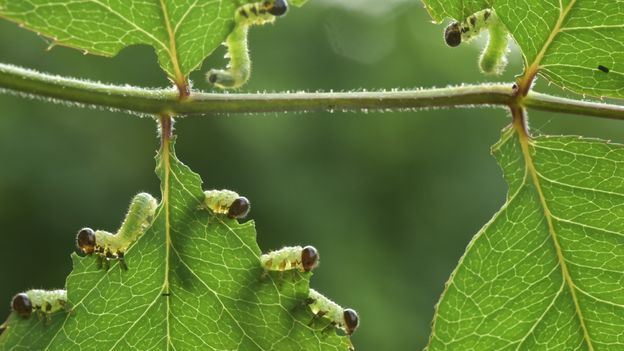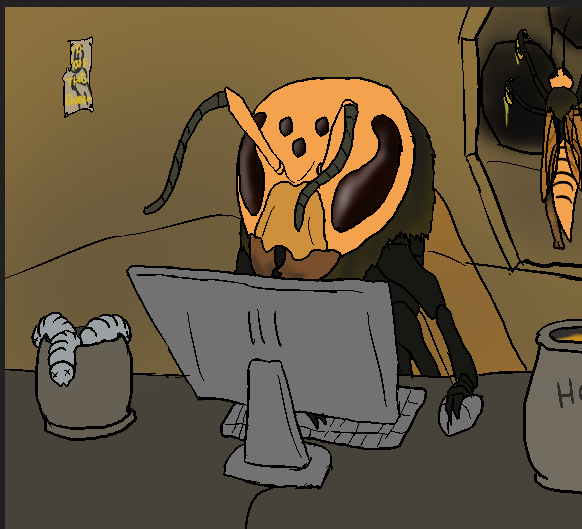spoiler
Renegade gardeners across the world are embracing a new philosophy: gardening that prioritises insects, not plants.
The marauders appeared out of nowhere. Looking through my window, I saw them – dozens of what looked like tiny grey caterpillars crawling all over a lovely green plant in my garden. I watched, with some horror, as over a matter of days, these insects chewed the plant to bits.
Countless leaves were munched to nothing, with only sad, spindly stems remaining. Finally, jet-black flies – the grey gobblers transformed – went buzzing off into the world beyond. Presumably, to wreak havoc elsewhere. Initially, I felt like a farmer whose field of maize had just been ravaged by locusts.
However, a little Googling set me straight. It turned out that the plant in question, the name of which was previously unknown to me, was Solomon's seal or Polygonatum – a classic cottage garden plant that, each summer, becomes locked in a tussle with the very insect invader I had witnessed: Solomon’s seal sawfly. A female sawfly had laid her eggs on my plant. Out of those eggs had hatched the grey larvae that ended up devouring it. And all of this was actually fine.
According to the UK's Royal Horticultural Society (RHS), Solomon's seal is relatively unbothered by this extreme defoliation. "This insect can be tolerated and the plants will survive," the RHS writes on its information page for the insect. What initially seemed like a macabre assault on a perfectly blameless plant was revealed to be just one of those many trade-offs that occur in nature all the time. Solomon's seal had evolved to simply shrug its shoulders and move on.
All over the world, there are insects that depend on plants for food. They munch at stems, and strip leaves to pieces. They make cuts and holes in otherwise pristine vegetation. To some gardeners, this is anathema. But others recognise that it's all a natural part of how ecosystems work – and without an insect-rich ecosystem, there would be no gardens at all.
Over the last few decades, a massive global crisis has affected insect populations, which are declining at a rate of between 1% and 2% every year. This means that practically any intervention that could help these creatures is valuable. More people are "planting for pollinators", with one 2022 survey finding one in three US adults purchase plants to help wildlife, an increase of 26% from 2020. This helps ensure there are lots of native wildflowers to supply bees, hoverflies and butterflies with nectar. But should we also try horticulture for herbivores, too? Should we plant things in the hope they will get gobbled up? To find out, I turned to the experts.
The beautiful red rose bush in a garden previously belonging to Hayley Jones, the principal entomologist at the RHS, was frequently the subject of debate between her and her husband. "He enjoyed the flowers – but I quite enjoyed looking at the sawfly," Jones tells the BBC. Various species of sawfly larvae would target the rose, she recalls – some would munch away at the leaves while others had very particular dining habits. "There's one species that rolls the leaves up," she says. "They eat it from the inside." A burrito for a bug.
The damage to the rose's foliage never really bothered Jones and, in general, she says she enjoys watching larvae and caterpillars chow down on plants. If you plant things destined to get eaten, you will naturally encourage the next link in the food chain, as predators such as birds come to your garden, too. A well-balanced garden shouldn't be munched down to the ground and left a wasteland – that should never happen in a biodiverse system, says Jones.
Having worked for the RHS for nearly a decade, Jones says she has noticed more and more gardeners expressing tolerance of herbivores. The frantic query of "how do I kill it?" from paranoid plant-coddlers has become less common, she explains. And many people enjoy the fact that very eye-catching insect species sometimes target particular plants – such as elephant hawk-moth caterpillars, which love to eat fuchsia.
"I have definitely heard people say they hope their fuchsia will be eaten because [the hawk-moth caterpillar] is just so spectacular," says Jones.
Another caterpillar some European gardeners enjoy looking out for is the yellow and black-spotted mullein moth caterpillar, which feeds on the flowering plants mullein and buddleia. Then there are cinnabar moth caterpillars, which have very striking black and orange stripes. They tend to eat ragwort.
By and large, insects that consume plants shouldn’t be called pests, argues Jones – they're just herbivores.
"My garden is primarily for insects," says Matthew Shepherd, director of outreach and education at the Xerces Society for Invertebrate Conservation in the US, a non-profit organisation that uses science to protect wildlife. "It gets pretty tatty just because there's so many things chewing and munching," he says. Shepherd doesn’t mind this at all. He spends hours just watching a variety of different bugs filling their bellies.
One key plant for American gardeners to consider growing specifically for the benefit of insects is milkweed, he says. This is because the caterpillars of the extraordinarily beautiful, yet endangered, Monarch butterfly love to eat milkweed, as do tussock moth caterpillars. People should choose a variety of milkweed that is native to their part of the country, though, he stresses.
"We need to be growing the milkweeds that will be emerging at the right time of year if the monarchs are passing through your region," he says. Sadly, now that this stunning migratory butterfly species is much rarer than it was, he no longer sees it in his own garden anymore – since his plot is located right on the north-western edge of their range.
Insects face all kinds of threats, and on a gigantic scale. For example, the use of pesticides across vast tracts of agricultural land. It might seem unlikely that diminutive private gardens can make much of a difference to their decline. But Shepherd insists that they can: "We're talking about small animals, so small areas do help."
Various studies indicate that simple decisions made by gardeners can affect insect abundance. One 2016 paper examined how the size and features of gardens in California influenced bee numbers, for instance. Having lots of flowers and patches of bare ground, which some bees nest in, were found to influence the insects' numbers positively. But nature doesn’t always react exactly how we might expect. Another study, from the UK in 2005, found that certain nettle patches didn't automatically attract lots of butterfly caterpillars, which are known to feed on these plants. However, they did attract other nettle-favouring herbivores.
Sam Stapleton, a botanical horticulturist at Kew Gardens in London, grew up marvelling at how various caterpillars happily chomped away on nettles, despite how painful these prickly plants can be to human skin. He spent his childhood observing such herbivory in the countryside and to this day gets excited when he sees a caterpillar chewing on a leaf.
Kew is renowned partly for its extensive, carefully planted gardens and glasshouses, some of which have housed rare plants for nearly two centuries. "It is a bit crazy to think I am being paid to create a habitat for animals and insects to eat the plants," he says.
Stapleton has been allotted an area within Kew where he is actively encouraging insect consumption of flora. He describes it as a small, mixed woodland-type habitat, with lots of native plants and flowers. This includes garlic mustard plants, which are eaten by the caterpillars of orange-tip butterflies. To encourage different kinds of insects, Stapleton has also put in piles of old logs, which many bugs love to hide in.
Although he wants to promote herbivory here, Stapleton is aware of other nearby plants that are suffering because of it. There is, for example, a large, very old box tree that has become the target of some very hungry caterpillars.
"It's a remarkable box tree and it's being completely demolished," he says. "The box will end up dying in a couple of years." It is one of those rare situations where he might consider spraying the tree to fight back against the caterpillars – for the sake of saving what is, in this case, a roughly 200-year-old plant. He would not use a chemical pesticide, and would instead consider an organic method such as a bacterial spray. But he is yet to make up his mind on what to do. For now, birds are coming to eat the caterpillars – just not frequently enough to save the box.
Luke Tilley, a spokesman at the UK"s Royal Entomological Society, can understand why gardeners sometimes get very upset when insects eat significant quantities of foliage. After all, their sense of indignation is arguably buried deep in our cultural psyche. The scale can be literally biblical, such as plagues of locusts – and, ever since agriculture emerged, humans have been battling herbivores and possibly even thinking of ways to protect their crops.
But Tilley says that a garden managed for biodiversity can support potentially thousands of species over a year. "That is a fascinating thought, as much as it is nice to admire your beautiful, tidy garden," he says.
He points out the sheer variety of inventive ways in which insects consume and disfigure plant matter. Take leaf miners, whose tiny larvae will literally tunnel inside a leaf leaving labyrinthine markings in their wake. Or stem borers and gall makers, which burrow into the stems of plants or produce strange, bulbous growths, often on leaves, respectively.
The other thing to remember is the surprising fact that plants are not entirely helpless in all this. Heidi Appel, Professor of Biology and Biochemistry at the University of Houston, was lead author on a 2014 paper that revealed how plants responded to being eaten alive by insects. The study found that herbivory changed the expression of certain genes in Arabidopsis plants, suggesting that plants do have a means of detecting when they are being eaten by herbivores and potentially defending against it. Not only that, the gene expression was different depending on which type of insect – caterpillar or aphid – was busy feasting.
Other plants have equally ingenious ways of responding to insect incursions. Take the cabbage and mustard plants that can kill off a tiny patch of their leaf when they detect that a butterfly egg has been laid on it – thus, preventing a caterpillar from hatching.
"In a few cases, insects feeding on plants can even cause a plant to make more flowers and fruit," says Appel. This is called compensatory growth and it has been documented in species including lima beans, soybeans and aspen tree seedlings. Appel notes, however, that regrowth always depends on the plant having enough resources to facilitate that growth.
The gardener who is perhaps most wary of herbivory, however, is the vegetable gardener. Huge clouds of aphids on tomato plants, slugs dining on spinach or caterpillars on cabbages – this natural process can ruin a tasty crop. It's why some introduce "sacrificial plants" such as nasturtiums, which will attract cabbage white butterflies, for instance, reducing the chance of them laying eggs on your prized cabbage instead.
Ben Vanheems, a spokesman for of Berks, Bucks and Oxon Wildlife Trust, who also runs the YouTube channel GrowVeg, loves watching caterpillars in his garden. However, every year he sees large congregations of blackfly on his broad beans. This can be problematic, but he has learned to tolerate them and rely on the predators he knows are waiting in the wilder, more untidy parts of his garden – helpful hoverflies and ladybirds.
"I know that if I just have faith, they will come and eat the blackfly," says Vanheems. "That happens every summer, actually, without fail."
If Vanheems sprayed his plants instead, although he would momentarily rid them of the blackfly, he would likely also impact the presence of those ladybirds. His beans, then, might be far more susceptible to the next swarm of blackfly to turn up. By keeping more of a balance in his garden, all species appear to benefit and he doesn’t need to rely on chemicals.
Perhaps more of us will be persuaded to marvel at caterpillars tearing apart a native shrub. Or take delight in the destruction of a Solomon's seal. After all, insects are a valuable part of global ecosystems. And they're hungry.
Like the concept but am growing tired of putting so much on the individual. The numbers would have to be in massive majority to replenish insects and plants compared to industrial farming having these same practices. Most people are too poor to have the space or the time to garden, much less research every plant and insect they see. With that being said, yes, please plant some more plants and and don't kill insects unnecessarily
This

Bug losses are a systemic problem, the biggest culprit is farming and the pesticide industry
Yeah it's quite the bummer. But even if it's systemic, we can't avoid personal accountability, so I better not see you burning ants with a magnifying glass claiming there's no ethical choices under the regime :)
Farming and pesticides, but it's also an issue of space in like a Marxist geography sense. Unless a city is intentionally cultivated as a biodiverse urban forest and garden city, that space may as well have an atom bomb occasionally go off for wildlife. Food and habitat availability are inconsistent and totally foreign to how they evolved if they're available at all. Their behaviours have to change rapidly under completely new evolutionary pressures that are completely the opposite of the grassland or forest or coast that was there before. They fly over vast stretches of grey asphalt to land on the green asphalt which is covered in poison looking for plants that no longer exist, all the while expending energy they can't replenish. Here the major plains cities are part of the seasonal migration patterns of cervids, with them feeding on the plains in the winter and progressively up the mountains through the summer. Without the county intentionally developing wildlife corridors, disrupting that and concentrating the populations in hostile mountain territory is the specific reason and region that gave us Chronic Wasting Disease. The space that's completely useless to wildlife without our new urbanist policies in response to those crises is like a 80km*270km stretch of wasteland.
Take away the immediate checks on their populations and those insects return to find green deserts which only get larger every year. There's an additional layer of needing to beat dialectics into peoples' head and get them to acknowledge that everything is an ecosystem made of ecosystems. Whatever we develop over an ecosystem needs to incorporate that ecosystem or the impact cascades over time because the carrying capacity and metabolic processes generating it are degraded for everything. If it's mandated from the top-down it faces reactionary resistance and here they've doubled down on worshiping hog shit. With a bottom-up approach it's creating a new value system which speaks to that Retvrn to Tradition Because 5G COVID part of their existing one. That new value system they're actively participating in makes them oppose the farming and pesticide practices we do once they see the same problems we do, the people learning through observation and all that. It has to come from somewhere and it won't be books.
I think the actual impact of individual homeowners doing it is marginal, but it's an important cornerstone for desuburbanisation which feeds into the socialist urbanism project. Having worked for a lawncare company, how we understand those spaces is absolute freak shit. People who really buy into the suburban ideal are unhinged to the point that they shake with glee describing how they want to kill all the squirrels around them. They'll sit in the desert sun picking clover out of their lawn that I'm about to cover in distilled piss and poison for hundreds of dollars, all of it going into the water that same person drinks from.
That's a power fantasy from the deepest reaches of moral protestantism and aristocratic divorce from nature. It needs to die yesterday on a societal scale. But individually every person who was indoctrinated into loving grass lawns and glyphosate gardening needs to purge the worms from their brain by replacing that with a different mission. If people are touching native grass and biodiverse gardens, be it as a homeowner xeriscaping or a renter like me who punishes bad landscaping with wildflower seed bombs or CSAs and community gardens, there's a stewardship switch that flips in their head understanding that they're the caretaker of something complex and more important than their own immediate benefit. It's in the same realm as the reforesting volunteering I do where we're covering an insignificant amount of acreage but each person has to consciously meditate on questions about nature for an entire weekend while learning to cooperate with it to make their surroundings better for them.
Yeah, keeping the bigger picture in our minds as we do anything is paramount. Wild and sad about the lawcare business, ideally they have deeper thoughts than just the outward conversations
Honestly just learning how to ID invasives goes a long way. Herbicides have their place in holistic land management I think. I've been beating back a half acre garlic mustard infestation for 3 years now. I'm finally getting the upper hand. Currants, wild berries and ferns are starting to show up more and more, and the ecosystem will be much healthier for it. It would have been impossible for me to do that without herbicides.
Its a far cry between that and carpet spraying your entire lawn for a "renovation" however
They have their use but it has to be a specialist usage in the same way you shouldn't prophylactically take Ivermectin to stay healthy. One as toxic as glyphosate works well for very small, selective applications in the right environmental conditions. As a horticulturist that's a whole professional certification I have to hold. It's if I carelessly apply it or do so in the wrong conditions or unnecessarily that it has secondary and tertiary impacts. My grandfather would just walk down the rows of his garden liberally pumping it onto anything that didn't look like a tomato or iris. That kind of better living through chemistry approach is the default mode a lot of people never think beyond with the result being wild over-application of the wrong thing at the wrong time.
Tomatoes are precious babies to be protected, but I use trap crops to deter insects from eating my good ones. They can have some marigold or basil instead. Their adult form is a good pollinator and food source for others.
Articles like this amuse me, as a person who gardens actively. It's all kumbaya for butterflies and native plants but that rapidly bumps up against the harsh reality of ravenous invasive species.
They make the mistake of only briefly touching on biocontrols at the end. I've still had wildly productive gardens without chemical inputs, but only because I'm actively managing it and paying close attention to what I'm planting and what's eating it and what eats that. Their "everything is partially sacrificial and plants can have a little wabi-sabi as a treat" approach is nice for landscaping in general while gardening for yield requires a lot of planning and intervention.









